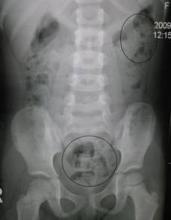STANFORD, CALIF. – An x-ray that shows that a child’s bowels are full of stool can help explain chronic abdominal pain to worried parents.
That’s a lot easier than convincing parents to accept the psychological causes behind functional abdominal pain, which is by far the No. 1 cause of chronic abdominal pain in children, Dr. Kenneth L. Cox said.
Constipation is – dare it be said – No. 2, he said at a pediatric update sponsored by Stanford University, and together these two problems account for about half of the cases of chronic abdominal pain that Dr. Cox sees in children.
Chronic abdominal pain is defined as intermittent or continuous pain that lasts for at least 1 month. Recurrent abdominal pain (defined as at least three episodes of pain occurring over 3 months or longer) affects 10%-25% of school-age children, and 80%-90% of it is functional abdominal pain, said Dr. Cox, chief of pediatric gastroenterology at Lucile Packard Children’s Hospital in Stanford, Calif.
In the evaluation of chronic abdominal pain in children, take a thorough history (especially psychosocial history), do a physical examination including a rectal exam, and ask the patient or parents to keep a pain log, he advised. Get a KUB (kidney, ureters, and bladder) x-ray, and consider ordering the following laboratory tests: CBC with differential; erythrocyte sedimentation rate; C-reactive protein; liver function tests; urinalysis; stool studies; and a spot urine amylase/creatinine ratio.
In the stool studies, order Hemoccult, fat, lactoferrin, Giardia enzyme immunoassay, Helicobacter pylori antigen, reducing substances, and pH, Dr. Cox added.
It’s important to rule out demonstrable disease to diagnose functional abdominal pain, which also requires continuous pain or at least one episode per week for 2 months or longer, he said.
The first step in treatment is reassuring the patient and family that functional pain is real and a common manifestation of stress, but that there is no organic disease. Treat with stress management; a high-fiber, high-fluid diet; drugs (which may include bulking agents, pain medications, anticholinergics, or antidepressants); and other therapies such as biofeedback, hypnosis, psychotherapy, imagery, yoga, or acupuncture.
The general screening studies will identify constipation as the cause of abdominal pain, which typically occurs in children who had difficulty around toilet training, Dr. Cox said.
Consider constipation to be chronic if the child has had at least two of the following problems for 12 weeks or more per year: fewer than three bowel movements per week and/or difficulty with more than a fourth of defecations (in the form of hard stool, straining, a feeling of incomplete evacuation, a sensation of anorectal obstruction, or the need for manual maneuvers to facilitate defecation).
These children have normal growth and normal anal tone with stool in the rectum. They’re usually at least 2 years old, and have encopresis.
Dr. Cox described a typical case of an 11-year-old boy complaining of 2 years of abdominal pain that was periumbilical, of short duration (usually lasting 1-3 hours), worse postprandially, and relieved by passing stool. The patient reported twice-weekly large, hard bowel movements, and he had smears of stool on his underwear (aka "skid marks"). His diet was low in fiber, with inadequate fluids.
With medical management, the constipation, encopresis, and pain will resolve. First, clean out retained or impacted stool using oral medications such as magnesium citrate, phosphor-soda, or polyethylene glycol. Enemas or suppositories also are options, but "I don’t like these," Dr. Cox said. "They’re a bit traumatic."
For maintenance therapy, prescribe a diet high in fluids and fiber. Add the child’s age plus 5 to calculate the number of grams per day of fiber that should be consumed, he said. Continue medications until the child has at least one bowel movement per day and no encopresis for 1 month. Teach the child to use the toilet after meals. Reward success with star charts or an age-appropriate reward, and avoid punishment, he said.
In patients who don’t respond, anal rectonometry may show abnormal defecation, such as an anal canal that does not relax during defecation. Biofeedback therapy incorporating video games can help train the child to relax the anal canal.
Besides constipation and functional abdominal pain, other common causes of chronic pediatric abdominal pain include gastroesophageal reflux, which often presents as pain in the abdomen (not chest), or abdominal wall injury from exercise. Drinking a lot of carbonated beverages can cause pain from aerophagia. Approximately half of chronic abdominal pain in adolescents involves lactose intolerance. Urinary tract infection, giardiasis, or H. pylori infection also are relatively common causes.



